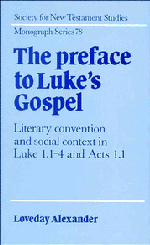Book contents
- Frontmatter
- Contents
- Acknowledgements
- Abbreviations
- 1 The Lucan preface: questions and assumptions
- 2 On the beginnings of books
- 3 Historical prefaces
- 4 Scientific prefaces: origins and development
- 5 Scientific prefaces: structure, content and style
- 6 Luke's preface
- 7 Prefaces in hellenistic Jewish literature
- 8 The social matrix of Luke's preface
- 9 The appropriate form of words for the occasion
- Appendix A Structural analysis of Luke 1.1–4 and selected scientific prefaces
- Appendix B Bibliographical notes on scientific prefaces
- Select bibliography
- Index of scientific authors
- Index of ancient authors and names
- Index of modern authors
- Index of subjects
2 - On the beginnings of books
Published online by Cambridge University Press: 15 October 2009
- Frontmatter
- Contents
- Acknowledgements
- Abbreviations
- 1 The Lucan preface: questions and assumptions
- 2 On the beginnings of books
- 3 Historical prefaces
- 4 Scientific prefaces: origins and development
- 5 Scientific prefaces: structure, content and style
- 6 Luke's preface
- 7 Prefaces in hellenistic Jewish literature
- 8 The social matrix of Luke's preface
- 9 The appropriate form of words for the occasion
- Appendix A Structural analysis of Luke 1.1–4 and selected scientific prefaces
- Appendix B Bibliographical notes on scientific prefaces
- Select bibliography
- Index of scientific authors
- Index of ancient authors and names
- Index of modern authors
- Index of subjects
Summary
The task
The task of establishing the literary affinities of Luke's preface may be seen as an exercise in mapping. The outer limits of the field can be drawn without much difficulty. We need to look at prose prefaces from the fourth century BC (by which time the classic genres of Greek literature were already established) down to the second century AD, the latest possible date for the composition of Luke–Acts. Within that period only extant prefaces will be considered as primary data: notices and testimonia (‘X wrote a book and dedicated it to Y’) are interesting but only of use to us at a secondary level, since it is essential to our study to examine the actual formalia of prefaces and dedications, the author's ipsissima verba.
It is not easy, however, to select a narrower area of relevance within this large field. Faced with a bewildering amount of potential comparative material, the critic tends to opt for one of three ways of narrowing the field: (i) to find parallels in a single author and posit him as Luke's direct model; (ii) to point to parallels in an area with which Luke's literary links are already well established, e.g. hellenistic Jewish literature; or (iii) to pick out a likely looking area on the basis of content (history, biography) and look there for preface-topics (e.g. discussion of sources, purpose of the work) similar to those found in Luke.
- Type
- Chapter
- Information
- The Preface to Luke's Gospel , pp. 11 - 22Publisher: Cambridge University PressPrint publication year: 1993



